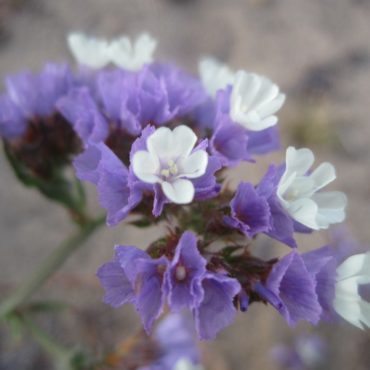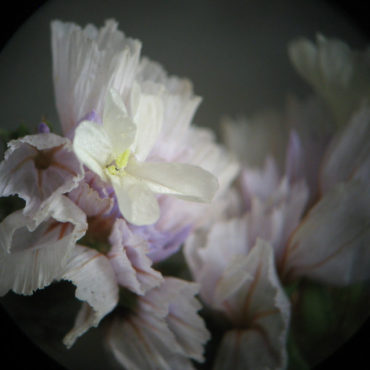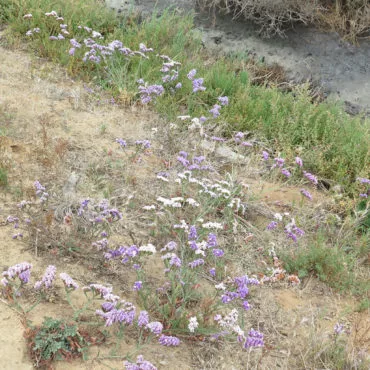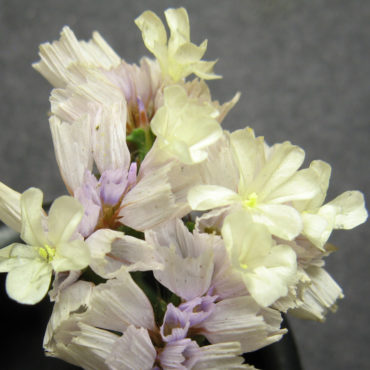There are four different species called sea lavender at the San Elijo Lagoon Ecological Reserve. They all belong to the genus Limonium, and can be recognized by their papery, colored calyx, which is often thought to be the flower itself. However, only California sea lavender (L. californicum) is native to California. Wavyleaf sea lavender (L. sinuatum) is native to the Mediterranean region, and is distinguished from the other sea lavender species by its deeply lobed (wavy) leaves and flat winged flowering stems which give it the names wavyleaf sea lavender, cut-leaf sea lavender and winged sea lavender.
Wavyleaf Sea Lavender (not native)
Limonium sinuatum
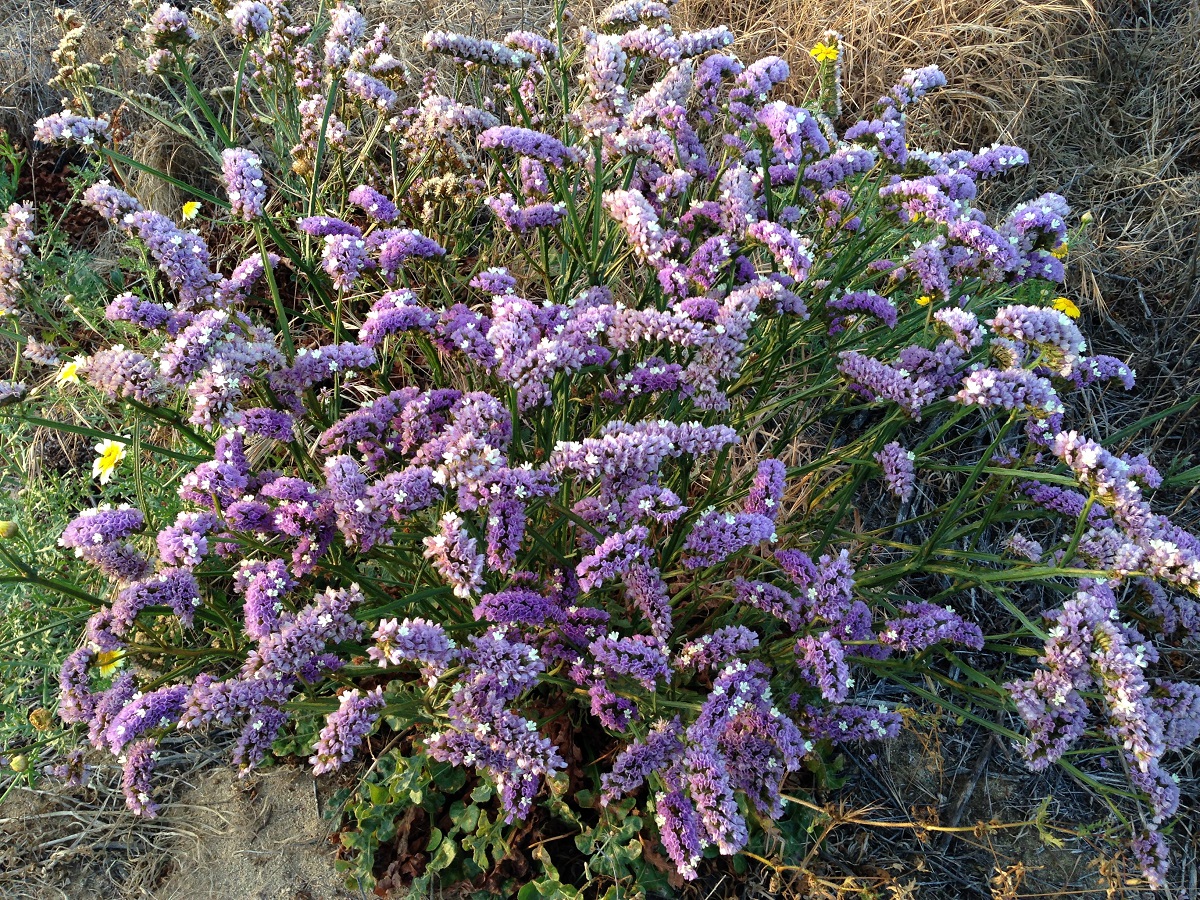
Other Common Names:
Cut-leaf sea lavender, winged sea lavender, notch leaf marsh rosemary, sea lavender, statice, wavy sea lavender, everlasting flower, perennial sea-lavender
Description 2,4,59
Wavyleaf sea lavender is a short-lived perennial herb that produces several branched flower stalks from a basal rosette of leaves. The stalks are hairy, and its leaves are deeply pinnately lobed, usually 1¼ -7 inches (3-12 cm) long, and tapered at the base; leaf margins are coarsely hairy.
Wavyleaf sea lavender is distinguished from the native sea lavender (L. californicum) by the stiff, winged flowering stems that reach up to 27 1/2 inches (70 cm) in height. Stems are leafless, but at each node, the wings extend outward forming a whirl of 3 to 4 narrow, leaf-like structures.
The flowers of wavyleaf sea lavender occur in much-branched, flat-topped clusters. Below the cluster, the stem wings extend outward into triangular, pointed leaf-like structures which, together with numerous pointed bracts, give the flower base a prickly appearance. The sessile flower is small, about ¼ inch (6-7 mm) across. The showy, papery, five-lobed calyx can be yellow, pink, white or lavender and is often mistaken for the corolla. The flower is symmetrical, with five stamens, one pistil with five styles, and generally white or yellowish petals.
Wavyleaf sea lavender blooms year round,7 and produces one-seeded fruits from early-March to mid-September. Each fruit develops within the persistent calyx.

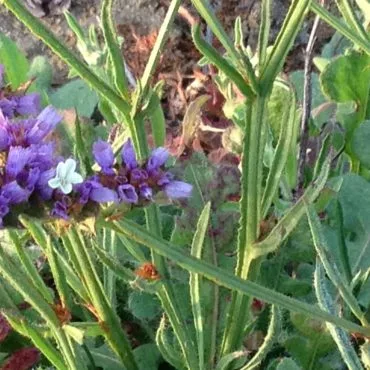
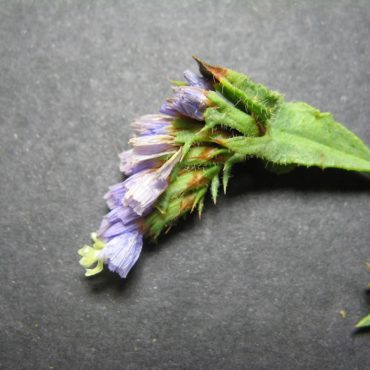
Distribution
Wavyleaf sea lavender, originally from the Mediterranean region, has widely naturalized. In western and southeastern Australia, it is now regarded as an environmental weed, since it has escaped from ornamental gardens, and is invading the native saline wetlands of those areas.235
Although it has naturalized in California, as of 2016, it has not been listed as invasive by the California Invasive Plant Council,183 but is widely distributed in coastal habitats such as beaches, salt marshes, coastal prairies as well as saline and alkaline areas. It is also common along the roadsides of Southern California.2
In San Elijo Lagoon Ecological Reserve, wavyleaf sea lavender is found on Harbaugh Seaside Trails and within West Basin.

Classification
Wavyleaf sea lavender is a dicot angiosperm in the leadwort or plumbago family (Plumbaginaceae). This family includes over 600 species of annuals or perennial subshrubs or vines,243 mostly associated with saline soils.44,176 However, only two species of this family are native to California, California sea lavender (L. californicum) and sea pink (Armeria maritima ssp. californica).2
Plants in the leadwort family are characterized by simple leaves that often bear glands on the surface, and by radially symmetric bisexual flowers, with five petals, five stamens, and five thin and membranous sepals, that may be more colorful and showy than the petals, and that remain attached to the fruit until maturity.2,176
The leadwort family includes some plants of horticultural value as ornamental plants in residential landscapes, including sea pink, some species of sea lavender, and plumbago.214
In addition wavyleaf sea lavender, there are four other species of sea lavender in the Reserve: California sea lavender, Perez’s sea lavender (L. perezii), European sea lavender (L. duriusculum) and Algerian sea lavender (L. ramosissimum).48
Alternate Scientific Names:
Statice sinuata

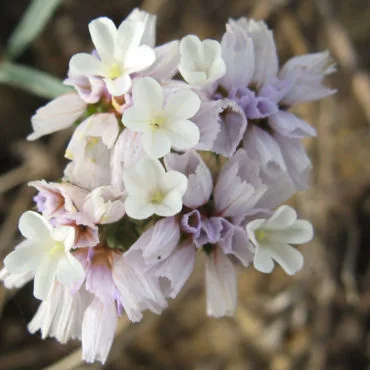
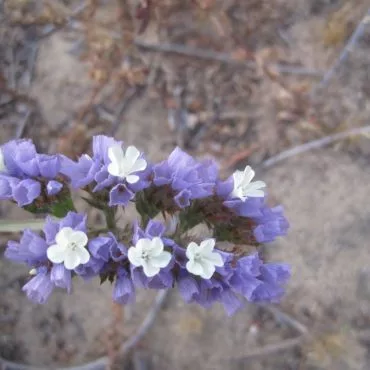
Ecology
Wavyleaf sea lavender is considered a moderate halophyte,179 a type of plant that has adapted to elevated concentrations of salts in the soil.236 Most halophytes, including wavyleaf sea lavender, can block the uptake of excess salts at their roots. In addition, they have salt glands in their leaves (sometimes called chalk glands in wavyleaf sea lavender). These structures can excrete the variety of salts that escape the blocking mechanisms at the roots.176, 237
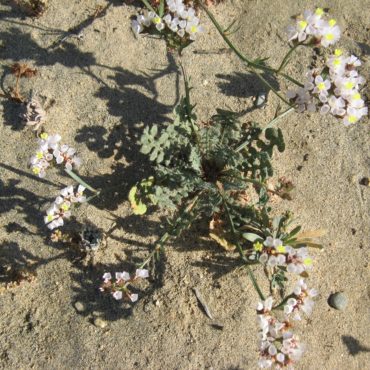
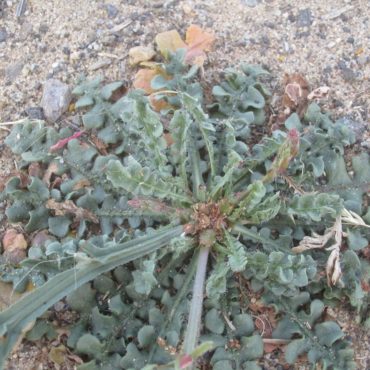
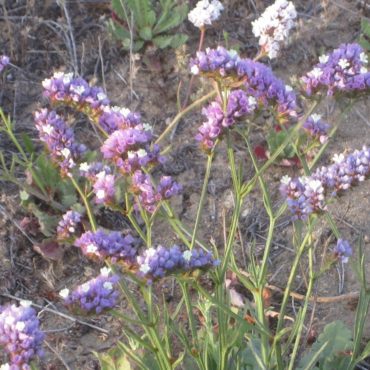
Human Uses
Several species of Limonium are important garden plants in Mediterranean climates.214 They tolerate heat and a variety of soil types; once established they need little water. The delicate papery flowers of wavyleaf sea lavender are popular for dry arrangements. In 2014, the USDA estimated the annual sales value for cut flowers of sea lavenders at over 1 million dollars.238
